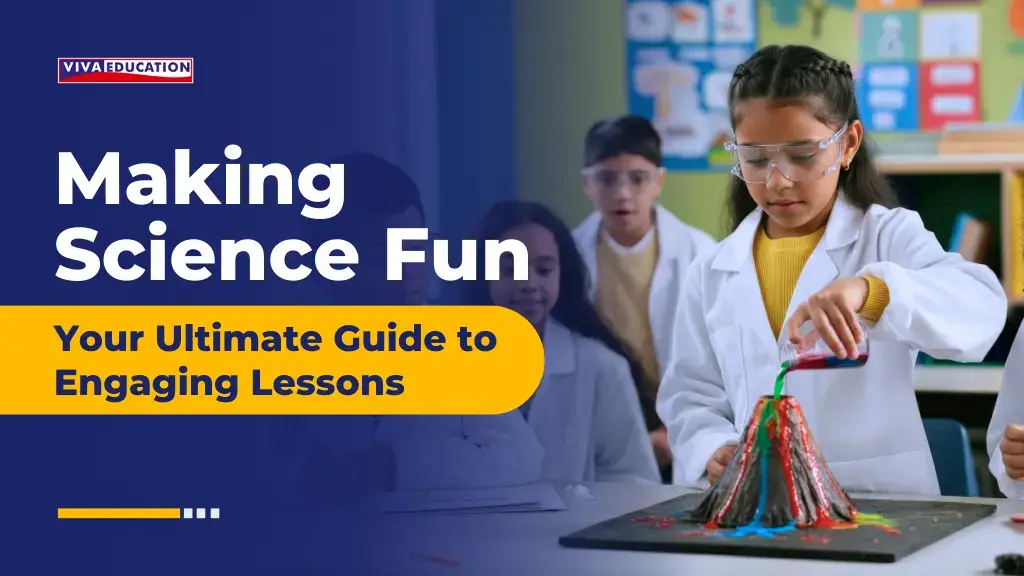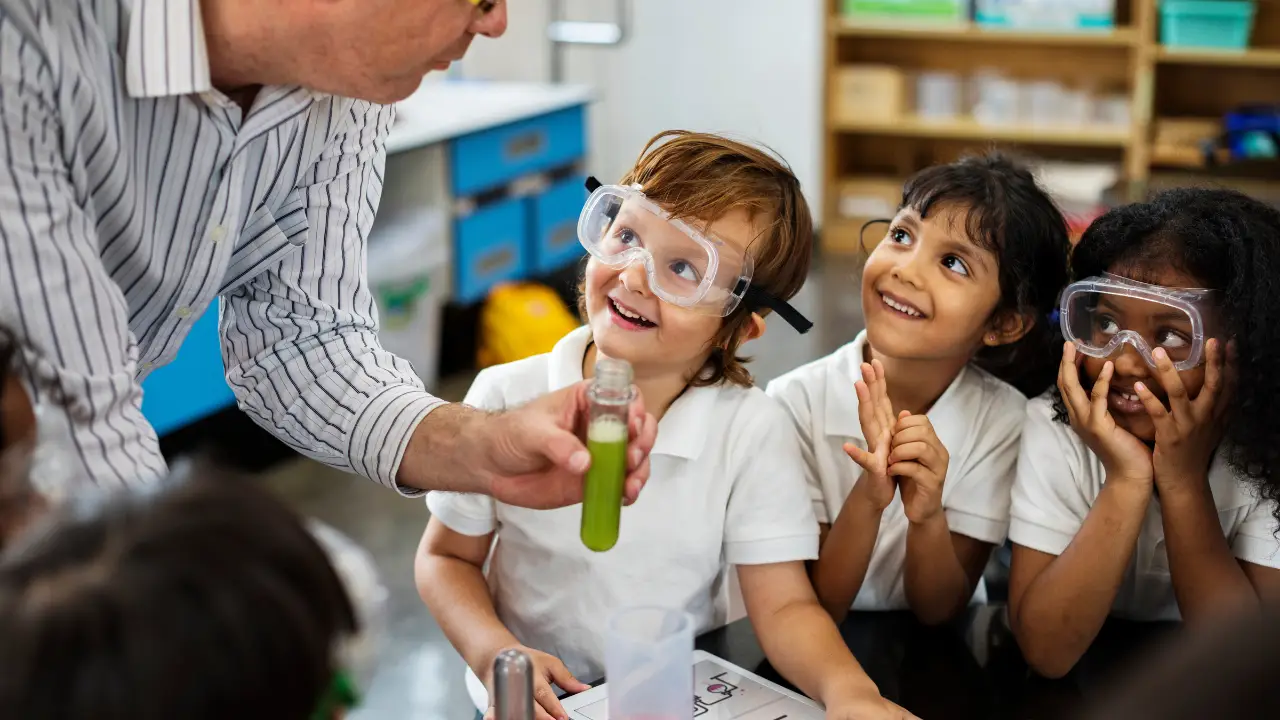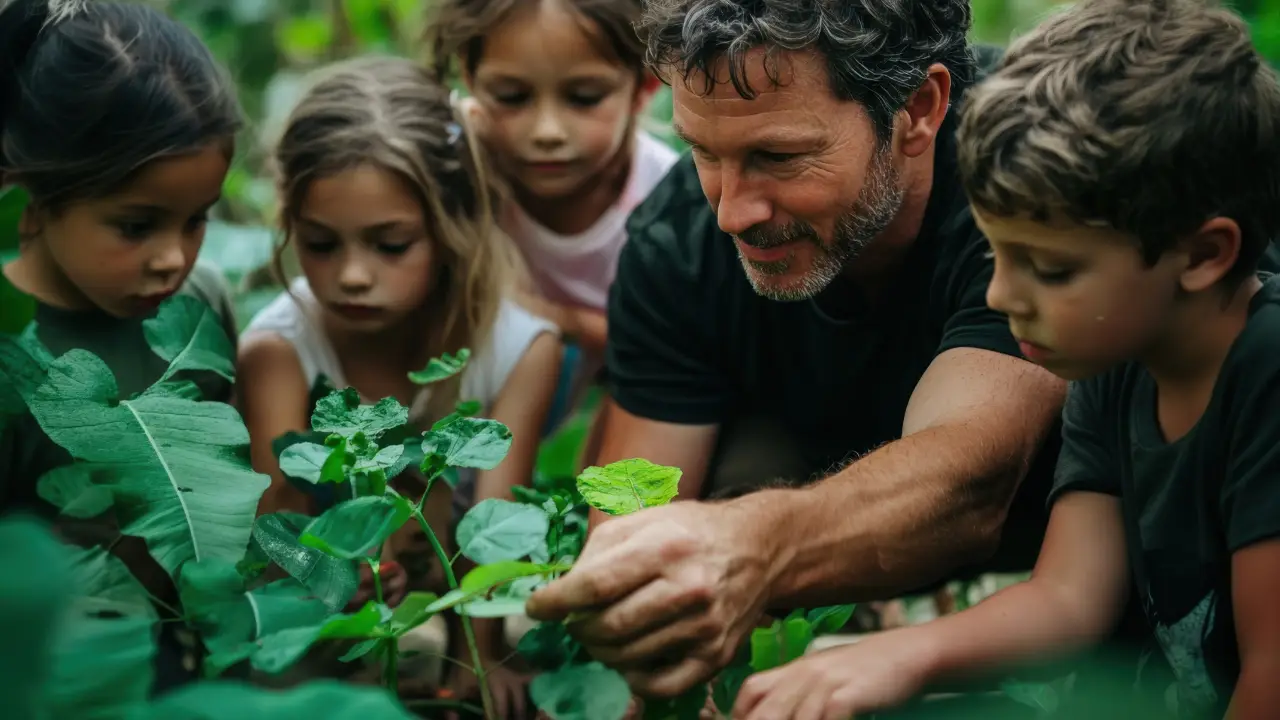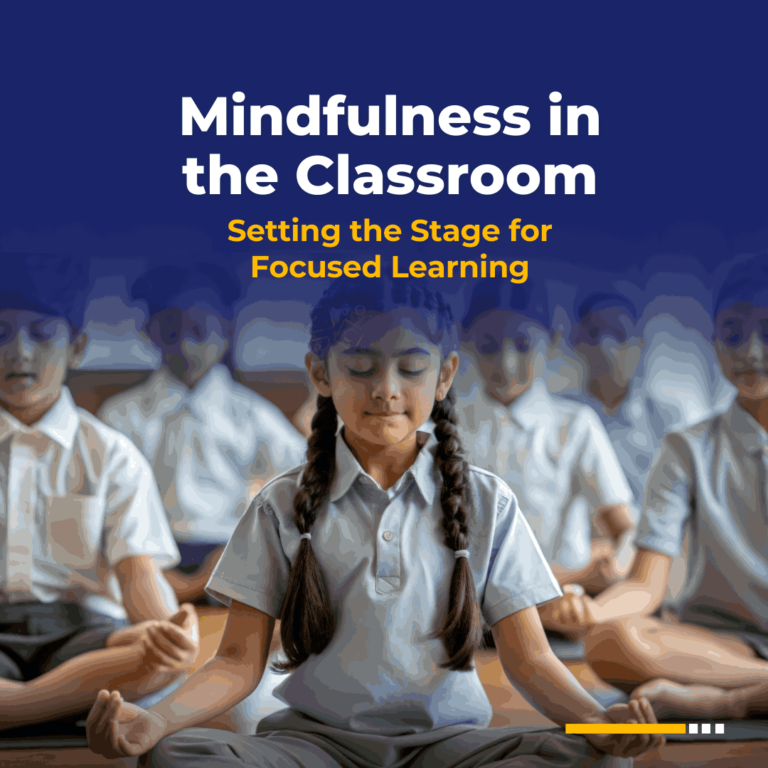Making Science Fun: Your Ultimate Guide to Engaging Lessons
- Teachers
- February 25, 2025
- Viva Education

It’s a strange world where a child can tell you the exact weaknesses of Pikachu but struggles to understand why a balloon floats. We’ve somehow made science less engaging than a fictional universe filled with pocket monsters. And frankly, the pocket monsters are winning.

Kids are wired for curiosity. They’ll spend hours mastering video game mechanics, yet science, the subject that explains the world around them, feels like a chore. The problem isn’t science itself; it’s how we teach it. Somewhere along the way, we turned discovery into dull memorisation. We must flip the script before all get zapped by a rogue thunderbolt of boredom.
To capture their interest, we must figure out how to make science fun—as exciting, interactive, and rewarding as their favourite games. So, where do we start? Let’s find out.
Challenges Faced by Students in Engaging with Science
Science should be a subject of curiosity and discovery, but for many students, it feels like a series of facts to cram before exams. They struggle with abstract concepts, feel overwhelmed by technical jargon, and often don’t see the real-world application of their learning.
As a result, their interest dwindles, and their engagement drops. This is supported by findings that show a concerning decline in student engagement, particularly in middle and high school. For example, A 2024 Harris Poll survey indicated that 46% of teachers have reported a decrease in student engagement since 2019.
This demonstrates a significant trend of reduced involvement in the classroom.
The Neuroscience of Fun in Learning
When students find joy in learning, their brains release dopamine—a neurotransmitter that enhances memory retention and motivation. This natural boost makes them more likely to engage deeply with the subject and retain what they’ve learned.
When students feel excited, they become more receptive to new ideas. Positive emotions ignite curiosity, encouraging them to explore even the most complex scientific concepts enthusiastically.
Strategies to Make Science Fun
A. Translate Lessons into Experiments
Science comes alive when students can see, touch and experience it. Hands-on science experiments transform theoretical concepts into tangible experiences, making learning memorable. Research shows that active recall and embodied cognition strengthen memory, making hands-on learning more effective than passive study.
Really Useful Tips to Supercharge Experiments:
- Empower Student-Led Design: Shift from pre-set instructions to empowering students to design their own experiments.
Instead of simply creating a lava lamp, ask them: “How can you manipulate it to flow faster or slower?
Design your experiment to test your hypothesis!” This cultivates authentic scientific thinking and ownership.
- F.A.I.L. – Embrace “Failure” as the First Attempt In Learning: Reframe mistakes as invaluable learning moments. When an experiment doesn’t go as planned, guide students through a constructive process:
1. Analyze the Process: “What aspects of our procedure might have led to this outcome?”
2. Troubleshoot & Iterate: “How can we adjust our approach to improve the experiment? What variables can we change?”
3. Re-test and Refine: “Let’s try again, incorporating what we learned.” This iterative cycle mirrors the core of the scientific method, building resilience and problem-solving skills vital for future scientific endeavours.
- Connect to Real-World Relevance: Elevate experiments by anchoring them in real-world issues.
When teaching density, move beyond the rainbow tower and ask: “How does density influence ocean currents and marine life?
Design an experiment to model the behaviour of oil spills on water and explore factors that might influence their spread.” This provides vital context and underscores the purpose of scientific inquiry.
- Engage Multiple Senses: Go beyond visual observation! Where safe and appropriate, encourage students to use all their senses during experiments.
“What does it smell like? What textures are you noticing? Are there any sounds being produced?” This multi-sensory engagement deepens understanding and strengthens memory encoding.
B. Encourage Hands-On Play
Neuroscience confirms the vital role of play in brain development. Unstructured and imaginative play is crucial for neuroplasticity, the brain’s remarkable ability to reorganize itself by forming new neural connections. When students, even older ones, engage in play, they actively construct new pathways that enhance creativity, problem-solving agility, and adaptability—all hallmarks of strong scientific minds.
Useful Tips to Embrace Play-Based Science:
- Dedicated Unstructured Play Time: Don’t solely rely on structured activities in science class. Designate a specific time for free, exploratory play with science-related materials. Provide resources, such as LEGO bricks, magnets, building kits and safe, recyclable materials.

Simply observe as students explore, build, and create without rigid instructions. Pay attention to what interests them and the questions from their play.
- Gamification with Real Purpose (Beyond Points): Moving beyond superficial points and leaderboards if incorporating gamification. Design games that authentically demand scientific thinking and problem-solving. Consider these examples:
1. Escape Room Science Challenges: Create a science-themed escape room experience where students apply scientific knowledge to solve puzzles and “escape,” making learning an engaging adventure.
2. Science-Based Board Game Design: Challenge older students to design games that teach a specific scientific concept effectively. This requires deep understanding and creative application of knowledge.
- Play Across Age Groups: Don’t mistakenly assume play is only for younger children. Adapt play-based learning strategies for older students, too. This might include:
1. Simulation-Based Games: These games leverage computer simulations or role-playing scenarios to explore complex systems, such as ecological simulations or pandemic modelling, making abstract concepts more interactive.
2. “Maker” Projects with Playful Constraints: Present older students with engaging engineering challenges framed as playful competitions, like building the tallest stable structure with limited resources or designing an intricate Rube Goldberg machine to achieve a simple task in a complex, playful way.
C. Explore the World Outside the Classroom
The biophilia hypothesis underscores the deeply ingrained human connection with nature. Spending time outdoors, especially in green spaces, demonstrably reduces stress hormones, sharpens focus and enhances overall cognitive function. This creates a more receptive and effective learning environment for science education.
Furthermore, when students engage with science in their local outdoor environment, they develop a robust “place-based” learning experience. This creates a profound connection to their geographical location and cultivates a strong sense of environmental stewardship—an intrinsic feeling of responsibility to protect and care for their local ecosystems.
Useful Tips to Deepen Outdoor Science Immersion:
- Engage in Citizen Science Projects: Elevate outdoor learning by involving students in scientific research in their community. Numerous citizen science initiatives welcome volunteer data collection for professional scientists. Consider these examples:
• Bird Counts (e.g., Audubon’s Christmas Bird Count): Empower students to contribute valuable biodiversity data through participation in established bird counts.
- Water Quality Monitoring: Engage students in testing local streams or ponds for pollutants, contributing real-world data to environmental organisations and community initiatives.
- Plant Phenology Projects: Have students track the timing of plant life cycle events (budding, flowering, leaf colour change) to understand and contribute to data on climate change impacts in their local area. This provides authentic science experiences and a profound sense of contribution to real-world research.

- Outdoor “Science Journaling” for Deeper Observation: Encourage students to maintain a dedicated science journal for outdoor explorations. Go beyond simple plant identification and use prompts that encourage deeper engagement:
1. Sensory Immersion
2. Inquisitive Wondering
3. Visual Representation
4. Personal Connection and Reflection
- Urban Environments: Science Labs in Disguise: Expand the definition of “outdoor science” beyond traditional nature preserves. Urban environments are also rich and often overlooked science labs. Explore these avenues:
1. Urban Ecology Studies: Investigate how plants and animals adapt and thrive in city environments, explore the impacts of urban pollution and analyze microclimates within urban landscapes.
2. “Nature in the City” Scavenger Hunts: Design scavenger hunts that challenge students to actively seek evidence of nature’s resilience within urban settings (e.g., plants growing in cracks, insects pollinating city gardens, evidence of urban wildlife).
- “Leave No Trace” Ethic: Cultivating Environmental Respect: Instill the critical importance of environmental ethics during all outdoor science activities. Explain “Leave No Trace” principles (minimize ecological impact, respect local wildlife, and leave natural objects undisturbed). This cultivates responsible environmental behaviour and a deep respect for nature’s fragility.
D. Explain Topics with Student-Friendly Books
Narrative learning is a powerful cognitive tool. Stories in science books make abstract concepts relatable, emotionally resonant and far more memorable. Stories centred on scientific discoveries, the lives of scientists, and even well-crafted science fiction can ignite curiosity and a sense of wonder, turning passive information absorption into active engagement.
In today’s information-saturated world, scientific literacy—the ability to understand, critically evaluate, and responsibly use scientific information—is more vital than ever. Teaching students to read science books critically is crucial for empowering them to become informed consumers of scientific information presented in the media and everyday life.
Improving Scientific Literacy Through Reading
- “Science Book Clubs” for Critical Discourse: Organize science book clubs where students read science books and actively discuss and critically analyze them in a group setting.
- “Fact-Checking” and Source Evaluation Skills: Equip students to become discerning readers of science information. When reading science books or online articles, actively guide them to critically evaluate sources by asking:
This critical skill is essential for navigating the digital age’s complex and sometimes conflicting scientific information.
Viva Education Science Books
As a leading science book publisher in India, Viva Education offers engaging and comprehensive Science books for schools that make learning interactive and enjoyable.
Our books are specifically designed to incorporate real-world applications, practical experiments, and compelling visuals, simplifying complex scientific topics and making them accessible to students of all learning levels.
We strive to be the best learning companion for every child, and our books reflect this commitment.
Check out our latest series, specially designed for today’s learners. Our New Direction Science series encompasses everything a student needs to build a scientific temper and support holistic development.
Additional Techniques to Engage Students
A. Animated and Multimedia Learning
Visual and auditory learning enhances comprehension. Videos, animations, and interactive apps help students grasp complex topics effortlessly.
Examples of Effective Multimedia Resources
- YouTube Channels – SciShow Kids, Kurzgesagt
- Apps – Toca Lab, NASA’s Eyes.
- Viva Education Teaching Resources
B. The “Wrong Answers Only” Approach
A counterintuitive but highly effective method is to challenge students to come up with incorrect explanations for scientific concepts. This forces them to engage more deeply with the subject.
Example:
- Ask: Why do plants grow toward the light?
- Encourage wild, wrong theories: Because they have tiny eyes! Because they are afraid of the dark!
- Then, guide them toward the correct understanding through discussion and experimentation.
C. Interesting Games
Games stimulate cognitive abilities and make learning interactive.
Examples of Educational Science Games
- Trivia Games – Kahoot quizzes on scientific topics.
- Board Games – Cytosis: A Cell Biology Game.
- Online Simulations – PhET Interactive Simulations by the University of Colorado.
Let the Fun Science Revolution Begin!
Students who are excited about science develop lifelong learning habits, curiosity, and critical thinking skills. Whether through hands-on experiments, engaging books, outdoor activities, or multimedia resources, every effort to make science enjoyable pays off.
So, what’s next? Let’s rethink the way we teach science. Start integrating these strategies into your approach if you’re an educator or a parent. Explore engaging books, introduce experiments, and make science an adventure for students.
Want more inspiration? Check out Viva Education and other resources that help make science a subject of wonder and excitement!
>> Please Share



